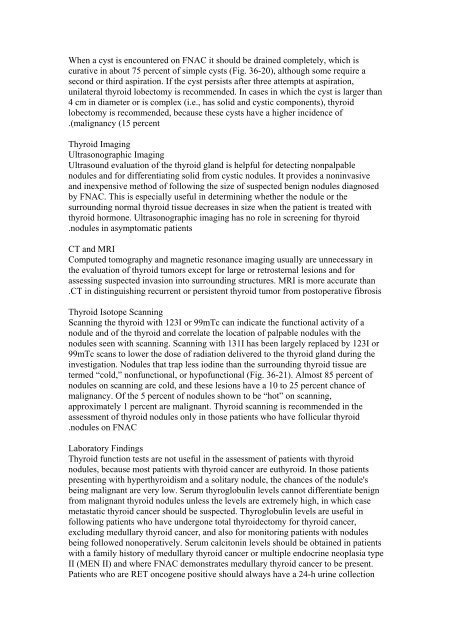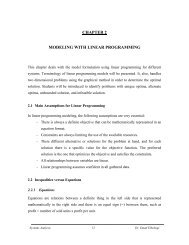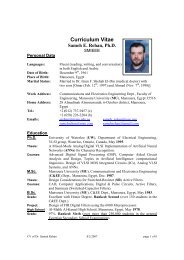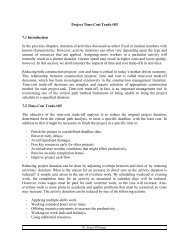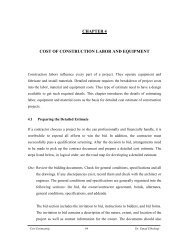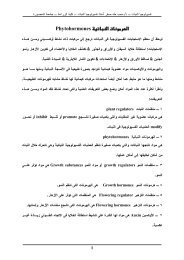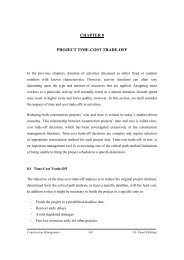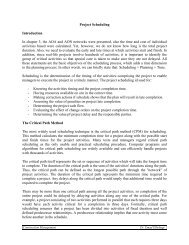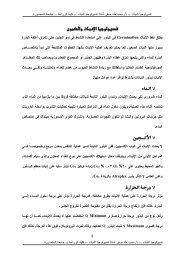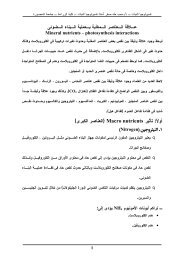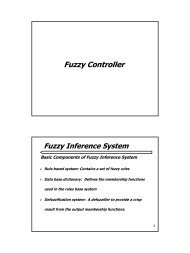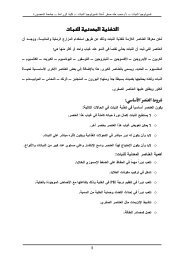Thyroid and Parathyroid
Thyroid and Parathyroid
Thyroid and Parathyroid
Create successful ePaper yourself
Turn your PDF publications into a flip-book with our unique Google optimized e-Paper software.
When a cyst is encountered on FNAC it should be drained completely, which is<br />
curative in about 75 percent of simple cysts (Fig. 36-20), although some require a<br />
second or third aspiration. If the cyst persists after three attempts at aspiration,<br />
unilateral thyroid lobectomy is recommended. In cases in which the cyst is larger than<br />
4 cm in diameter or is complex (i.e., has solid <strong>and</strong> cystic components), thyroid<br />
lobectomy is recommended, because these cysts have a higher incidence of<br />
.( malignancy (15 percent<br />
<strong>Thyroid</strong> Imaging<br />
Ultrasonographic Imaging<br />
Ultrasound evaluation of the thyroid gl<strong>and</strong> is helpful for detecting nonpalpable<br />
nodules <strong>and</strong> for differentiating solid from cystic nodules. It provides a noninvasive<br />
<strong>and</strong> inexpensive method of following the size of suspected benign nodules diagnosed<br />
by FNAC. This is especially useful in determining whether the nodule or the<br />
surrounding normal thyroid tissue decreases in size when the patient is treated with<br />
thyroid hormone. Ultrasonographic imaging has no role in screening for thyroid<br />
. nodules in asymptomatic patients<br />
CT <strong>and</strong> MRI<br />
Computed tomography <strong>and</strong> magnetic resonance imaging usually are unnecessary in<br />
the evaluation of thyroid tumors except for large or retrosternal lesions <strong>and</strong> for<br />
assessing suspected invasion into surrounding structures. MRI is more accurate than<br />
. CT in distinguishing recurrent or persistent thyroid tumor from postoperative fibrosis<br />
<strong>Thyroid</strong> Isotope Scanning<br />
Scanning the thyroid with 123I or 99mTc can indicate the functional activity of a<br />
nodule <strong>and</strong> of the thyroid <strong>and</strong> correlate the location of palpable nodules with the<br />
nodules seen with scanning. Scanning with 131I has been largely replaced by 123I or<br />
99mTc scans to lower the dose of radiation delivered to the thyroid gl<strong>and</strong> during the<br />
investigation. Nodules that trap less iodine than the surrounding thyroid tissue are<br />
termed “cold,” nonfunctional, or hypofunctional (Fig. 36-21). Almost 85 percent of<br />
nodules on scanning are cold, <strong>and</strong> these lesions have a 10 to 25 percent chance of<br />
malignancy. Of the 5 percent of nodules shown to be “hot” on scanning,<br />
approximately 1 percent are malignant. <strong>Thyroid</strong> scanning is recommended in the<br />
assessment of thyroid nodules only in those patients who have follicular thyroid<br />
. nodules on FNAC<br />
Laboratory Findings<br />
<strong>Thyroid</strong> function tests are not useful in the assessment of patients with thyroid<br />
nodules, because most patients with thyroid cancer are euthyroid. In those patients<br />
presenting with hyperthyroidism <strong>and</strong> a solitary nodule, the chances of the nodule's<br />
being malignant are very low. Serum thyroglobulin levels cannot differentiate benign<br />
from malignant thyroid nodules unless the levels are extremely high, in which case<br />
metastatic thyroid cancer should be suspected. Thyroglobulin levels are useful in<br />
following patients who have undergone total thyroidectomy for thyroid cancer,<br />
excluding medullary thyroid cancer, <strong>and</strong> also for monitoring patients with nodules<br />
being followed nonoperatively. Serum calcitonin levels should be obtained in patients<br />
with a family history of medullary thyroid cancer or multiple endocrine neoplasia type<br />
II (MEN II) <strong>and</strong> where FNAC demonstrates medullary thyroid cancer to be present.<br />
Patients who are RET oncogene positive should always have a 24-h urine collection


